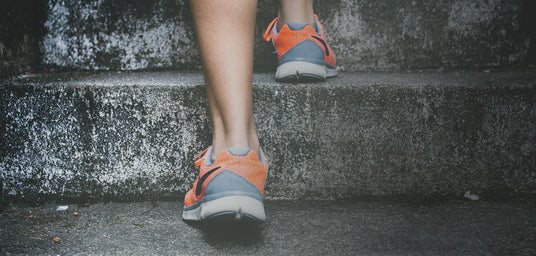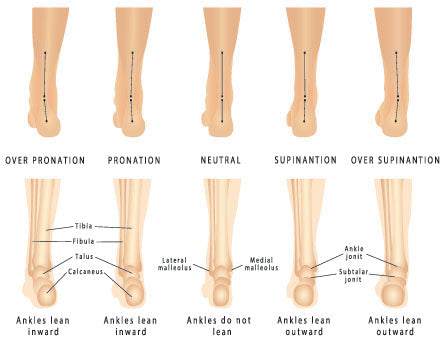Underpronation: Causes, Symptoms, and Treatment
Underpronation (or supination) occurs when your feet roll outward as you walk. Over time, this can strain the muscles in your feet and legs and increase your risk of injury.
You may not notice it as you go about your daily routine, but as you walk, your feet naturally move from side to side. This natural and necessary movement is called pronation and is an important part of absorbing shock with each step.
People with high arches, however, may be at risk of underpronation (supination) - a condition when the arches of the foot do not roll inward/downward enough when walking. Pronation is a natural movement of the foot; however, if your ankle does not roll enough, you are underpronating and at risk of injuries to the foot or ankle.

Pronation is a natural movement of the foot, however if your ankle rolls too much you are overpronating.
What is pronation?
Before we can define underpronation, let’s first define pronation and what the natural movement of your foot looks like.
You may think that a morning run is the simplest of sports – just lace up your sneakers and get at it, right? It’s a bit more complex than that, and no, we don’t mean that you should stretch before you hit the pavement.
There is a key piece of equipment you use with every run: your feet. Every time your foot strikes the ground, a series of coordinated movements absorb shock to keep you moving forward and keep your body in balance. One of these movements is pronation.
There are three kinds of pronation:
- Normal/neutral pronation: Neutral pronation is when your foot rolls inward naturally to absorb shock and keep you balanced. It is normal for the foot to roll inward, around 15%.
- Underpronation (supination): Underpronation occurs when the foot rolls outward when you make contact with the ground. This most commonly occurs in people with high arches and can cause Achilles Tendonitis, Plantar Fasciitis, Shin Splints, and IT Band Syndrome.
- Overpronation: Overpronation occurs when your foot rolls more than 15% and downward when you step. People who overpronate are said to have ‘flat feet’ and are at risk for injuries such as IT band syndrome and plantar fasciitis.
What is underpronation?
Every time you walk or run, your foot naturally pronates and supinates to absorb shock.
As you step on the ground, this movement allows your foot to become a mobile adaptor. It then swings into a rigid lever to help you propel forward. This mechanical process is a natural marvel. However, if you have low arches or poor form it can be thrown out of balance.
When your foot is inflexible and does not roll inward enough (less than 15%) this causes the foot to roll outwards and put excess stress on the ankles and toes.
This can also occur when you have high arches, which limit the range of motion of the foot as you walk.
What Problems Does Underpronation Cause?
Underpronation can cause a host of injuries to the foot and ankle. As your foot and ankle absorb excessive stress over time, underpronation can put you at risk for conditions such as:
- Ankle sprains
- Heel spurs
- Plantar fasciitis
- Shin splints
- Calluses or Bunions
What is the difference between underpronation and overpronation?
Underpronation and overpronation are two sides of the same coin: they both refer to how much your foot rotates (pronates) as you walk.
Overpronation is a condition where your foot rotates too much as you walk; this excessive rotation puts strain on the foot and toes, which can lead to injury over time.
Underpronation is a condition where your foot does not rotate enough, keeping your weight on the outside of your foot which puts excessive strain on your foot and ankles, which can also lead to injury over time.

When your foot is inflexible and does not rotate enough underpronation occurs
What causes underpronation?
Underpronation is commonly found in individuals with high arches, which leads to a limited range of motion (pronation) in the foot as you walk.
Those with one of these foot types may have been born that way or may have acquired it over time because of genetics or injury. There is little one can do to prevent the cause of underpronation, but there are things that can be done to remedy the problem.
How can I tell if I underpronate?
There are a few simple ways to tell if you underpronate:
- The wear test
- The water test
The Wear Test
You can try the ‘wear test’ by examining your running shoes for wear.
If you underpronate(supinate), then you will have wear on the outside of the foot, from the pinky toe down the outside edge of the shoe.
If you overpronate the shoe will show excessive wear along the inner edge from the big toe towards the ball of the foot.
Neutral pronation will have relatively even wear down the middle, mostly in the toes/ball of the foot and the outer heel.
The Water Test
Another simple test is the ‘water test’. All you need is to wet your foot and examine your footprint on a dry surface - a piece of cardboard works great for this.
Simply wet your foot and step down. A neutral footprint will have a thinner midsection, and those who underpronate will have a very slight midsection as most of their weight is on the outer edge of the foot. If you overpronate, you’ll have a very wide footprint in the middle as more of your foot comes in contact with the ground.
Treatment for underpronation
Underpronation is not a wholly curable condition however, you can mitigate the risks of it and keep your feet healthy. You have a couple of options to treat/mitigate:
- Choose the right shoes
- Wear supportive insoles/orthotics
- Stretch regularly
Choose the Right Shoes
Proper footwear can work wonders for keeping your feet healthy.
To mitigate risk from underpronation, choose supportive, comfortable shoes that have a thick and cushioned sole, plenty of arch support, and fit snugly so they keep your feet secure. Some may prefer shoes that cover the ankle so they provide extra stability and can help avoid rolled ankles or falls.
Make sure to replace your shoes regularly as well. Shoes break down and lose their support over time, so replacing your shoes every 6-12 months will ensure you have maximum support from the ground up.
Wear Supportive Orthotics/Insoles
If your shoes lack support, you can easily add some with insoles/orthotics. Look for insoles that provide quality arch support but are not hard and rigid. Supination insoles usually have a little bit of flexibility to them. They are designed to help absorb shock and guide the foot into a natural motion of pronation.
You may be prescribed custom orthotics. However, there are plenty of high-quality generic orthotic inserts that can add support to your shoes and provide support for underpronation. Here are some of the best insoles for underpronation:
- Form Maximum
- Ten Seconds Ultra Arch
- Prothotic Ultra Arch
- Superfeet All-Purpose High Arch
- Birkenstock Blue Footbed
Stretch Regularly
Due to the damage underpronation presents to the foot, ankle, and leg, stretching is a great way to mitigate risk and prevent injury. Stretching on a regular basis can keep your muscles and ligaments flexible yet strong and provide additional stability to your gait.
What to Look For When Buying Insoles For Underpronation
When selecting insoles for underpronation (also called supination), you'll want features that encourage proper inward motion while providing cushioning for impact absorption. Here are the key elements to look for:
- Maximum cushioning: Underpronators typically have rigid feet that don't absorb shock well, so look for insoles with substantial cushioning throughout, especially along the outer edge of the foot. Materials like gel or soft foam provide the necessary impact absorption.
- Neutral to low arch support: Too much arch support can worsen supination by pushing the foot further outward. Look for more neutral support that doesn't force the foot into any particular position.
- Lateral (outer edge) support: Some specialty insoles for underpronation have extra cushioning along the outer edge to help distribute pressure more evenly across the foot.
- Flexible construction: Rigid insoles can worsen underpronation. Choose more flexible options that allow natural foot motion while still providing cushioning.
- Wide platform design: Insoles with a slightly wider base can help improve stability for underpronators who tend to roll onto the outer edge of the foot.
